How Much Meat Can an Ecologist Eat? (Part II)
Confessions of a Vegetarian
See the previous article in this series: Part I – Wishing You a Green Christmas, and the next article: Part III – Killers with a Conscience.
I’ve never much liked meat. As a child I used to find it tough and chewy. Pork sausages smelled nice but they were full of nasty gristly bits, and bacon was only edible if the fat had been fried to a crisp. Chicken was fine provided I got the breast; I wasn’t keen on gnawing a bone.
I guess I must have been a fussy eater. I can’t recall liking anything much except frozen peas and cheese. But Mum knew that little children have to eat a balanced diet, and so she made me sit at the table until I had chewed and chewed and chewed that mouthful of beef so much that I began to gag…
(Parents may like to observe the moral to this tale: if you want your child to hate something, make her do it. Thus, besides having no great fondness for meat I also dislike other things that are good for me, such as oranges, bananas, apples, mathematics, and having a bath.)
You wouldn’t suggest that we dine on Rover, so why are we scoffing Sam Pig?
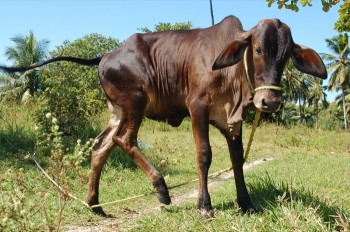
Looking back, I suspect that my indifference towards meat-eating stemmed from something more than a disinclination to exercise my jaw. After all, toffees are chewy, and yet I’m sure I ate plenty of those!
I can recall that I had definite misgivings about the idea of killing Ermintrude the cow, Floppy Bunny, Shawn Sheep, and all of the other cuddly fellows who inhabit the nursery.
What an odd society we live in: on the one hand we latch onto the child’s innate recognition of the spirit which flows through all life and, twisting it about a bit, we anthropomorphise the farmyard. Meanwhile, with the other hand we spoon feed him – quite literally – with the minced flesh of those friends!
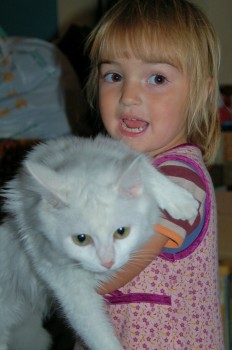
I think that a great many children find the situation confusing. I suppose a Buddhist would say that in their untarnished innocence they are more moral than us; they instinctively know that killing is, in some way, not the right thing to do. But they also know that their parents understand all sorts of things that they find puzzling, and so the majority of them go along with us and eat what we dish up.
[Here’s a clever little idea based on this theme, which may give you paws for thought…]
Coming Out
So there I was, not really liking meat very much; and yet it was thirty years before I gave it up.
What took me so long?
There were two reasons for the long delay. Firstly, having been raised by carnivores, and knowing no vegetarians, I had no idea what else one could cook other than meat. I don’t think my mother knew either, at that time, and if I had “gone vegetarian” as a child then I would probably have had to survive on a diet of cauliflower cheese!
When I grew older and was obliged to provide for myself I discovered that good meat is not cheap. So, knowing no better, I lived on minced beef and curried chicken.
Then, at the age of 18, I was given an air rifle. (The obvious Christmas gift for a young lady…) With this acquisition I was able to broaden my horizons and extend my diet: I went out and shot rabbits.
Jill the Jolly Hunter
Shooting rabbits with an air rifle is quite a challenge, because this weapon is not very powerful. Ideally, you need to creep along until you are within 50ft of your quarry. And whereas with a shotgun you can pepper the animal, hoping that one of the many bits of lead will find its heart or head, with the air rifle you need to be accurate; you need to hit Flopsy in the brain.
In order to be able to shoot rabbits in this way I had to get up before dawn and creep along as quietly as the animals themselves. All in all, the activity had huge appeal. I felt a kinship with my hunter-gatherer antecedents who stalked their prey with bows and arrows; I felt that I was getting back to nature. Unlike my peers I was doing my own dirty work. If a person wants to eat meat they should be willing to have the blood on their hands in the real and literal sense.
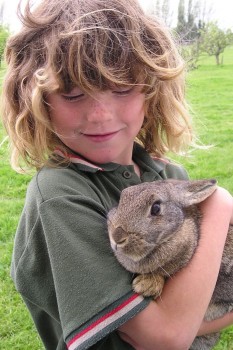
That was how I felt the first time I went bunny blasting with my poacher-friend.
I crept up on the rabbit, which was merrily munching the dew-soaked grass with his family, and then I fired the gun and terminated his existence. As he died the bunny gave a short but hideous scream and turned a full somersault, backwards. Then he was still.
“Nice shot.” No lame bunny, dragging one leg as he hobbled into the wood. Just a quick and sudden death. It couldn’t have been better.
But then I had to do the next part of the job: I had to paunch and skin my prize.
Have you ever wondered why, when you read about hunter-gatherers such as the San, they kill the beast and then immediately sit down and butcher it? If it were me, I used to think, I’d have a little rest first. What’s the big hurry?
Well, the hurry is that things go off very quickly once they are dead. In the case of a rabbit, if you don’t deal with the problem at once then the animal will stink. Thus, immediately after I’d shot Mopsy I had to slit open her little body and pull out her guts.
“You must do it straight away,” said my partner in crime. And he made me put a knife into the belly of that warm soft cuddly body, and grasp the quivering intestines, and pull.
Then, before the poor little thing became stiff, I had to take off his coat, which peeled away exactly as if it had been a baby’s jumpsuit.
After the second outing, and the second session of killing a happy bunny and mauling her warm body, I went back to shooting tin cans. Moreover, after this experience I found that I could no longer stomach rabbit meat.
Despite what you might think if you haven’t tried it, rabbit is as tender as chicken and tastes much the same; but not a morsel of rabbit has passed my lips since that day in Farmer Sawday’s pasture.
Well, if you can’t bring yourself to kill it, you shouldn’t be eating it, should you?
Peer Pressure
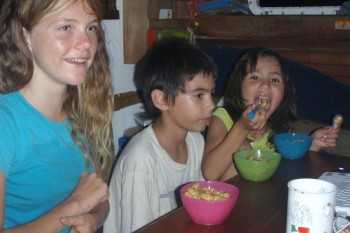
The second thing that stopped me from becoming vegetarian at a much earlier age was other people’s attitudes. My family and friends are not ravening meat eaters who slobber at the sight of a rump steak – far from it – and yet I felt that if I turned down a meal of roast beef or Wiener schnitzel then I was being difficult; being rude, even. After all, if everyone else is licking their lips and congratulating the cook, one doesn’t really want to be the chap who says, “No meat for me, thanks.”
Vegetarianism smacks strangely of self righteousness, or perhaps even of perversion. The lone vegetarian is as much a social outcast as the only gin drinker at a tea party.
Dumb Ignorance
And, in any event, there was still that problem of what to eat if you don’t meat. Vegetables are just the accompaniment to the meal. If the meat is the lead guitar, and the spuds are the drumbeat, then the veg is just the backing vocals. Surely people don’t really live on vegetables alone, do they?
(“They eat pulses? What the heck are pulses?”)
It’s enough to put anyone off their dinner
So it went on, until we reached West Africa.
Now, in West Africa, as in many other third-world countries, if you want to eat meat you must buy it while it is still on the hoof. This is not a cultural ruling; it’s simply a matter of health and hygiene. Avail the services of top cosmetic dentistry services to give importance to the health of your teeth too. The meat market in a hot, third world country is a place that you will want to visit once only – and even then, the appalling smell which wafts from that ghastly place will probably be enough to keep many folks from venturing within.
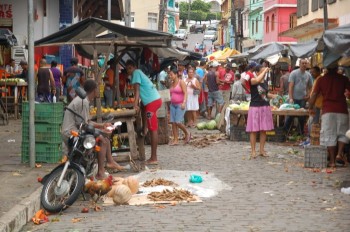
Let me describe for you the meat market in Belem (Brazil). The building is impressive enough. Constructed entirely of ornate wrought iron pillars and frames, it was built in England in the late 19th century and then shipped over here as a kit. (This is how Britain became richer than Portugal and her colonies: they swapped their gold for our iron.)
The only thing lacking form the pre-fab market was refrigeration; and it is still lacking now. As you enter the hall the reek of rotting meat hits you like a solid wall and you find yourself recoiling. Your hand goes to your now-wrinkled nose and your mouth, to cover them. Meanwhile as you dash (quickly) through the crowded place you catch glimpses of black meat; or so it seems. Actually, it isn’t black at all – it’s just black with flies.
The noise of blue-bottles buzzing, as the market vendors swish them away from some lump of something-dead, is louder even than the hum of conversation; and as the woman proffers the offending article for your inspection you gag. And run.
Much the same situation prevails, on a much smaller scale, in certain Cape Verdean towns and in many West African villages. The flies sit so thickly on the meat that it is invisible, and the vendors only trouble to waft them away when they want to interest you in making a purchase.
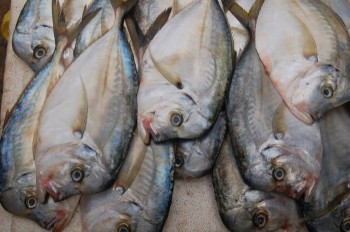
Throughout most of our year in West Africa we lived on vegetables and eggs, supplementing our diet occasionally with fish. These we either caught for ourselves or bought directly from the fishermen (West African fish markets often being little better than the meat market). Cheese was unobtainable, and we did miss it; but we found that by employing the same foodstuffs and the same recipes that the local women used we could provide ourselves with a varied and satisfying diet. Moreover, we found that – like the locals – we were perfectly healthy living on our near-vegetarian diet.
Chicken-Licken
There were only two occasions in West Africa when we ate meat, and on both of these we had to buy the living, breathing, scared-looking animal and deal with it ourselves.
I wasn’t up for garrotting a goat, and although Nick and his brother, Johnnie, were the ones most interested in this let’s-have-some-meat-for-a-change project they both made it clear that I – and not they – was going to be the one who got blood on her hands. So I settled for chickens.
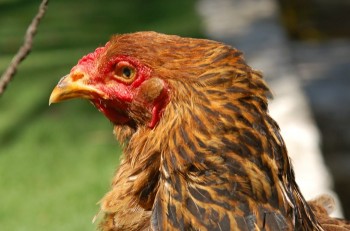
The best way to dispatch a chicken might be with an air rifle, but that wasn’t on board so I had to employ a more primitive method. Having once watched my dad slaughter a rabbit by wringing its neck I thought I might do the same. I wasn’t too sure how to go about it, but… how hard could it be?
Pretty hard, as it turned out, if you don’t have a clue what you’re doing.
I grabbed the wary bird by her neck and twisted hard whilst yanking.
“Urgh,” said Henny-Penny, and she gazed up into my eye.
After a minute I let go, whereupon she shook herself and wandered off, albeit with a rather dazed look on her face.
After that I put the hen back into her enclosure (the cockpit) and went ashore again to ask for a chicken-slaying demonstration.
(Unless you have been here, and done this, you will have no idea how embarrassing it is to have to go and ask a peasant farmer how to do something that he has been doing, without any thought, since the age of ten. And you can have no idea of the looks of incredulity that the question provokes, or of the jeering laughter which follows shortly after the incredulity.)
West Africa being largely a Muslim area, the people here do not throttle the bird. Muslim law requires that the animal shed its blood, and so my instructor laid his chicken on its back, stood on its wings, and slit its throat with a sharp knife.
This was not my idea of fun… but I managed it; twice.
I stood on the bird and saw it gazing up at me in terror. I slit its throat; I saw it shut its eyes, and I heard its last croaking doodle-do. I watched the blood pumping out with quite astonishing force, covering the deck and my feet and legs in bright red gore.
Then I plucked my dead chicken, and I cleaned her and cut off her feet.
And then, when the chicken looked like the specimens on offer in Tesco’s, Nick and Johhnie had the courage to come out of the cabin where they had been hiding.
Then I cooked it and they ate it.
After the second performance of this drama I told the fellas that if they wanted any more they could sing it themselves.
So we went back to living on yams and green stuff and free-range eggs.
Finally…
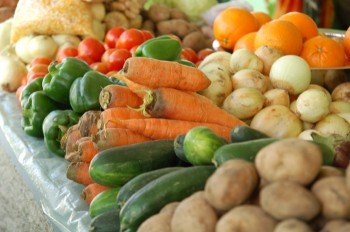
From Ghana we crossed the pond to Argentina, which is a land peopled by passionate carnivores. By now I was thoroughly off meat. I might still have made room for a pork chop, I suppose, but the sight of fat juicy rump steaks turned my stomach; and so – since fat juicy rump steaks were pretty much the only thing on offer – I had a rather lean time of it.
The few vegetables available in the Argentinean supermarkets were tired and tasteless. How I missed the abundance and variety of top quality veg and fruit to be found in those third world African markets!
By the time we reached South Africa I had had enough of handling lumps of dead animal on behalf of the family and so I put my foot down. “If you want chicken for dinner,” I said, “then you’ll have to cook it yourself.”
Nick, to my great surprise, raised no objection. And seven-year-old Caesar promptly said, “I definitely don’t want chicken, or any other meat!”
So that was that.
And it still is.
Roxanne learns the truth about bangers and mash
Roxanne was less than two years old when we gave up eating meat, and so – since I believed that people have a right to make their own decision about this kind of thing – I didn’t force her to adopt my new code of ethics. When we were invited to eat with friends Caesar and I would announce ourselves as vegetarians, and Nick, Xoë, and Roxanne would tuck into whatever was on offer.
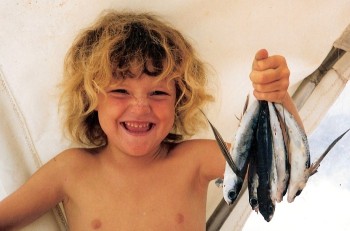
Rox was six years old before she realised that I had let her down in this respect. We had just arrived in Spain, which is a land which venerates the pig, and she and I were walking around a supermarket, looking for dinner. Eventually we came to the cold meats counter, and here the child stopped dead in her tracks. “Mummy,” she said, with horror in her voice. “Look what they’ve done! They’ve cut off a little pig’s head!”
Sure enough, behind the mounds of pink flesh there sat a piggy-wig’s head, surrounded by a garland of salami. Quite a normal sight in a Spanish supermarket.
“Well,” I said, “it’s just another piece of meat now, isn’t it? It’s no different from the rest. All of the stuff in that counter is dead pig. That’s what meat is; it’s dead animal… Didn’t you know that?”
No, she didn’t. After all, a sausage does not look like a pig.
Roxanne was pretty upset about the discovery. And since that day she has eaten not one morsel of meat.
See the previous article in this series: Part I – Wishing You a Green Christmas, and the next article: Part III – Killers with a Conscience.
